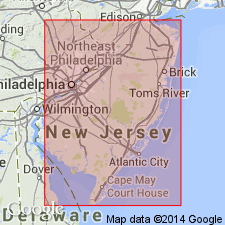
- Usage in publication:
-
- Woodmansie phase
- Modifications:
-
- Named
- Dominant lithology:
-
- Sand
- AAPG geologic province:
-
- Atlantic Coast basin
Summary:
Bridgeton formation has two distinct contemporaneous phases. They are here called Glassboro phase and Woodmansie phase. The Glassboro is better known and is developed in the southwest part of the state. It consists primarily of gravel and sand, arkose in many places. The Woodmansie phase occurs east and north of the Glassboro. It is not arkose and is without crystalline rock, shale, red sandstone, etc., of the Glassboro phase. It is more largely sand and is thinner. It was derived chiefly from the Miocene and Cohansey formations.
Source: GNU records (USGS DDS-6; Reston GNULEX).
For more information, please contact Nancy Stamm, Geologic Names Committee Secretary.
Asterisk (*) indicates published by U.S. Geological Survey authors.
"No current usage" (†) implies that a name has been abandoned or has fallen into disuse. Former usage and, if known, replacement name given in parentheses ( ).
Slash (/) indicates name conflicts with nomenclatural guidelines (CSN, 1933; ACSN, 1961, 1970; NACSN, 1983, 2005, 2021). May be explained within brackets ([ ]).

